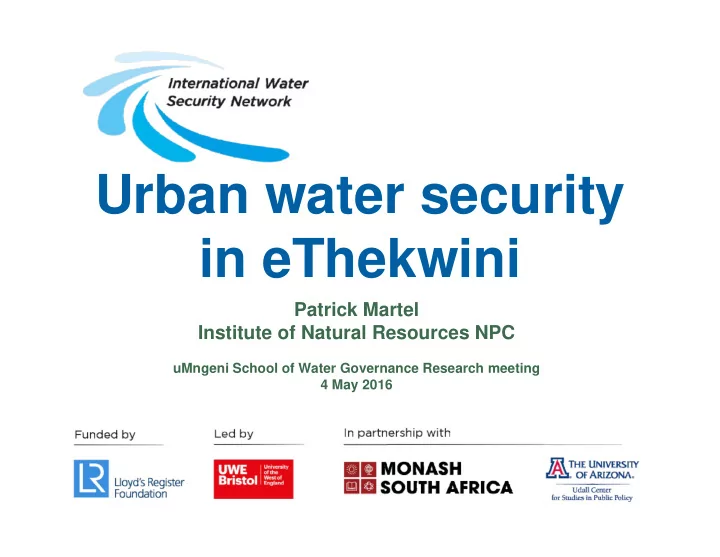

Urban water security in eThekwini Patrick Martel Institute of Natural Resources NPC uMngeni School of Water Governance Research meeting 4 May 2016
Introduction Water scarce context Important to analyse the relationship between water and society in order to enhance water security This study Temporally explores urban water security in Durban Achieved by applying the urban hydrosocial transition model over the history of the municipality Based on the focus of my internship at INR Proposed PhD topic 2
Conceptual Framework Urban hydrosocial transition (UHT) model developed by Staddon and Langberg (2014) Historical geographic framework that can be used to interrogate the complex and changing relationship between cities and water services over time Cities are conceptualised as manifestations of successive hydrosocial contracts between agents of economic, political, cultural and technological change (Staddon and Langberg, 2014). Analysing hydrosocial contracts between government and the general public provides analytical insights into the social construction and production of water in a given time and space, as well as the ways that this becomes evident to society and the power relations which instigate hydrosocial change (Linton and Budds, 2013). 3
UHT Model The UHT model is characterised by three distinct phases over time Hydro-precarity (pre-1914); Piecemeal and chaotic local arrangements Hydro-modernism (1914-1992) Mass provision of standardised water supply and sanitation services Hydro-security (post-1992) Mass restructuring in the water services industry -> new roles of the public and private sectors, new technologies and the water needs of the natural environment How to apply the UHT model Identify case studies for each phase Identify unique factors Identify underlying drivers of change (critical moments of change) 4
Hydro-precarity phase History Creation of the Borough of Durban in 1854 7000 settlers and 34km 2 in size Initial reliance of water from private wells and rainwater Poor water quality (Brackish) Drainage was required in the Eastern Vlei Change in the hydrosocial contract between the municipality and the public Local government began to provide water for the general public Public wells (Currie’s Fountain 1879) – first water pipe network Plumbing into the Umbilo, Umhlatuzana and Umlaas Rivers (started the reliance on surface water) Free water for residents and industries Linked with the ability to secure finance (loans) Three long-standing powerful engineers from the 1880s British educated, continuity in leadership No augmentation plans were rejected between 1880s and 1920s 5
Hydro-precarity cont. Change in the hydrosocial contract between the municipality and the public cont. Growing population Spatial expansion of Durban Greater number of people (South African war 1899 to 1902) Re-occurrence of natural disasters Flooding and droughts Incremental development of Durban’s water services Racial discrimination Blaming of Black and Indians for water quality problems and diseases 6
Hydro-modernism Context Growing population, spatial increase in the size of Durban, re- occurring natural disasters Resulted in the need for more water from far away ‘Plumbing’ into the uMngeni River Construction of major dams; large aqueducts Centralised approach -> central solution to increase capacity and supply Special Works Department in the 1950s and 1960s (capital intensive; large investments; very fast acting) Durban Heights -> constructed the largest covered reservoir in Africa 7
Hydro-modernism cont. National policies and legislations impacting on the local level (Change in hydrosocial contract) National Water Act of 1956 Impact of apartheid ideology on water and sanitation provision Inequitable access to water under apartheid/discriminatory practices Water as a ‘securitised’ resource in South Africa Riparian rights system linked to the ownership of land -> biased towards white farming and industrial interests Relationship between the national and local government - strained Establishment of Umgeni Water Board in 1974 ( change in hydrosocial contract ) 8
Hydro-security Context at the national level Significant shift in the conceptualisation of water in 1993/1994 (change in the hydrosocial contract) Riparian rights were no longer supported Change in national legislation and policies Section 27 of the Bill of Rights; White Paper of Water and Sanitation (1994); National Water Act (1998); Water Services Act (1997); Free Basic Water policy (2000); Mbeki’s State of the Nation address (2004); commitment to the Millennium Development Goals; Municipal Systems Act (2000) Water belonged to the people Government as the custodian of water Licencing of water (abstraction and pollution) The allocation of water Water needed for the Reserve (reflects hydro-security) Water for the poor 9
Hydro-security cont. Context at the local level Changes in administrative structure New municipal boundaries eThekwini Municipality is approximately 2 297km2 in size Approximately 3.5 million people White and Bantu Authorities Centralisation under eThekwini Municipality Umgeni Water Spring Grove Dam (hydro-modernism) Urban Development Line in eThekwini Spatial differentiation of services for water and sanitation Urban core versus peri-urban Three different service levels with different technologies ( hybrid system ) Ground tank systems in rural areas Semi-pressure supply received by the household via a roof tank Full pressure water supply fed directly to the household from the supply network 10
Hydro-security Water re-use Industries Most recent moment has focused on the role of ecological infrastructure How the catchment-wide rehabilitation and management of natural infrastructure can improve water security in the city Pilot projects Green Fund project 11
Conclusion Context has shaped the hydrosocial contract in Durban from the 1850s Durban as a growing city Spatial growth and population increases Needs a greater supply of water Incremental development associated with the re-occurrence of natural disasters Influence of powerful, long-standing engineers in the local government Impact of National legislation and policies Impacts the local level and shapes urban water security Durban has a hybrid water supply system, which is heavily reliant on surface water 12
www.watersecuritynetwork.org www.twitter.com/water_network Acknowledgement The project is funded by Lloyd’s Register Foundation, a charitable foundation helping to protect life and property by supporting engineering ‐ related education, public engagement and the application of research. For more information, see: www.lrfoundation.org.uk
Recommend
More recommend